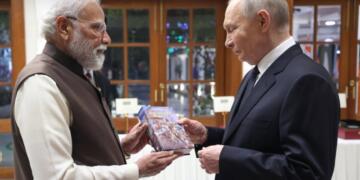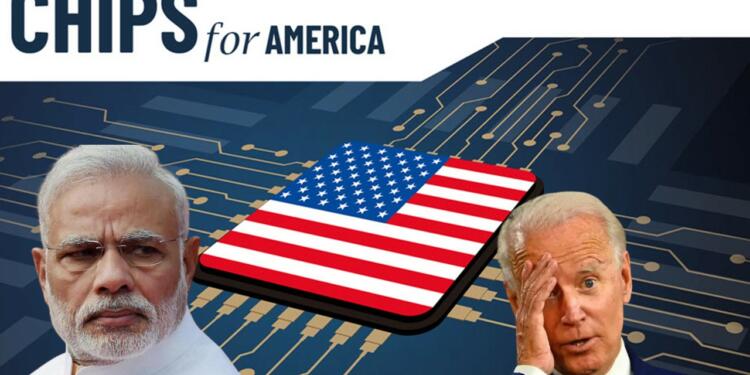US CHIPS Act: In an ever-evolving world, there is always a need to go with the change. The one that stops progressing becomes oblivious. Since the invention of computers, the world has continuously strived for technological advancement. This resulted in computers becoming compact and telephones becoming handy.
And now is the phase when we are witnessing Industrial Revolution 4.0, which incorporates artificial intelligence among others. This gives rise to the necessity of more sophisticated products and commodities, the major among them being semiconductors.
But the vested trade interests now seem to destabilize this attempt. The first blow to global aspiration has come from the USA. But India has clearly indicated that it is in no mood to let the US compromise its efforts.
Indians take on the US CHIPS Act
The World Trade Organization (WTO) routinely reviews the trade policies of individual member countries. Reports highlight that during the US Trade Policy Review, India opposed the US CHIPS Act, which was announced in August last year. India raised the objection, citing the WTO provisions, and termed the act disadvantageous for other countries. Further, New Delhi also sought clarification from the United States regarding its act.
As per the official statement, India asked, “This puts more competitive manufacturers globally at a distinct disadvantage. What steps are proposed to be taken to create an even playing field for global manufacturers in these areas, especially from the developing world?”
China too questioned the US CHIPS Act
Interestingly, along with India, China too questioned the US act. It is noteworthy that China is in a feud with the USA on the semiconductor export ban issue. It has also filed a lawsuit against the USA in the WTO.
In the Trade Policy Review, China raised the issue, saying, China notes that the US has continuously criticized the industrial subsidy policies of other members on various occasions over the years. Please clarify whether the consistent position of the US has changed.”
Replying to this, the USA said that it intended to act in a manner that is consistent with US laws and with US commitments under the WTO agreement.
But is that so!? There is a WTO agreement on Subsidies and Countervailing Measures (SCM Agreement). Some of the provisions of the US Act violate these WTO agreements.
But before that, let us understand the semiconductor dynamics across the world, due to which things are getting more conflicting.
Semiconductor initiatives by the USA and India
Let’s rewind a bit. The pandemic and Ukraine conflict disrupted the global supply chains of semiconductors. Being the most important hardware in the electronic industry, there was hardly any technology-based sector that remained unaffected. Each country initiated the effort to augment its capabilities in developing the semiconductor ecosystem.
India too started developing infrastructure for the same and launched the “Semicon India Programme” with an outlay of $10 billion in 2021. The key objective of this programme was to set up fabrication labs for developing R&D and designs to compete with the major players in Asia.
In 2022, semiconductor fabrication was allotted an additional $10 billion in outlays under the PLI scheme.
In August 2022, the US, on the other hand, passed a piece of legislation called the ‘(Creating Helpful Incentives to Produce Semiconductors for America (CHIPS) Act. As per the provisions of the act, the government will provide $52 billion in subsidies and a total of $280 billion in incentives to restore America’s dominance in global semiconductor manufacturing.
How does the US dominate the chips segment?
Going by numbers, it is interesting to know that the USA is the dominant player in the manufacturing of semiconductors. The most critical part of semiconductor production is Electronic Device Automation (EDA), which designs the chip before it is manufactured.
EDA is a costly process for mainly two reasons. Firstly, each end product demands different semiconductors, thereby demanding different software automation. Lastly, this complex process requires skilled engineers and vast R&D. And being the most competent country in current times, the US dominated EDA with a share of more than 74 percent.

So, whatever the manufacturing capacity of China, Hong Kong, and Taiwan, without the US, semiconductor fabrication is a hard nut to crack, almost impossible. One example of this is Apple. It designs its own chips, while the manufacturing of the chips is outsourced.
China failed in the competition!
It is not like China never worked out the details of semiconductor architecture. But the chances of success are very low, and the cost incurred is very high. Every year, $20 billion in investment is required in chip fabrication research and development.
A tiny square inch of a chip contains billions of transistors placed just nanometers apart, making the chip more powerful with greater transistor density. Apple’s iPhone 13 currently uses the most advanced 5-nm chip, while their upcoming iPad is expected to be the first to use a 3-nm chip, which offers a 15% faster speed and 25% lower power consumption compared to the 5-nm chip.
In contrast, China’s most advanced chip is 14 nm, which is at least two generations behind the 5-nm chip, despite the country’s two decades of significant government funding. This demonstrates how much the system is dominated by the United States.
How is the US backstabbing India?
In such a challenging market as well as technological competition, India’s dream of becoming a semiconductor hub is no less than facing headwinds. In its effort, the geopolitical conditions, along with a dedicated home government, acted as reinforcement. The US wants to reduce Chinese dominance so that its influence can be contained. This also gives an advantage to India. This was evident in the so-called chip war between the US and China.
As a result, Taiwanese companies are ready to relocate to India. The US also supported the cause, at least on paper. India and the USA launched iCET (the Initiative for Critical and Emerging Technologies), under which semiconductor fabrication in India was also to be supported. Along with that, recently, US Secretary of Commerce Gina Raimondo travelled to India to sign the memorandum of understanding with Commerce and Industry Minister Piyush Goyal. The MoU is based on the semiconductor supply chain and ‘Innovation Partnership’.
Also Read: India and US Team Up on Semiconductors, Setting the Stage for a Showdown with China
But since hypocrisy has always been the USP of the United States, it took no time to show its real colours.
Actually, India is exhausting its capital on semiconductor fabrication because the domestic demand for electronic goods and electric vehicles is continuously rising. It does not want to become dependent on foreign players, especially China. But this will face more chances of failure because of the US CHIPS Act.
The incentivization and subsidy will make US semiconductors cheap and technologically faster. This will certainly disrupt market norms, and Indian startups will eventually take the biggest blow.
The US act is heavily criticised on the basis of the same. It is argued that the act will not only affect China but also affect other manufacturers in Asia.
But one can say that any country will think of its own market and people. True! But it is the same US that opposes subsidies and incentives, citing WTO provisions.
US CHIPS Act : WTO provision
WTO provisions under the SCM agreement clearly prohibit certain types of subsidies that are considered to be trade-distorting. These include export subsidies, which are subsidies that are contingent on export performance, and subsidies that are tied to the use of domestic goods over imported goods.
So, the Indian criticism of the US is actually the most important step, which was desperately needed. The step evidently shows that the current Indian approach to the world is more pragmatic and less idealistic. This is certainly going to reap benefits for India in the near future.
Support TFI:
Support us to strengthen the ‘Right’ ideology of cultural nationalism by purchasing the best quality garments from TFI-STORE.COM





























